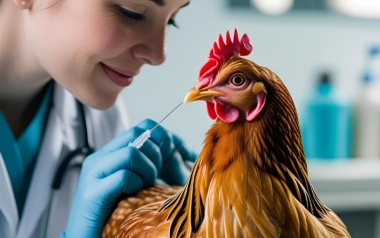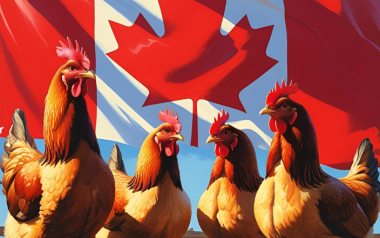Prevention of Bacterial Infections in Poultry Flocks
25 Mar 2021
Minimizing the first week mortality in chicks caused by bacterial infections
As the immune system is not fully developed at hatch, chicks are particularly susceptible to several viral, bacterial, and parasitic infections. High mortality rates during the first week tend to be very common in poultry productions because of omphalitis, respiratory tract infections, airsacculitis, and septicemia.
Available in other languages:
As the immune system is not fully developed at hatch, chicks are particularly susceptible to several viral, bacterial, and parasitic infections. High mortality rates during the first week tend to be very common in poultry productions because of omphalitis, respiratory tract infections, airsacculitis, and septicemia.
Some studies have reported that infections produced by E. Coli can represent up to 70% of the total mortality within the first 72 hours after the placement. In yolk sac infections, Salmonella species are considered the second most common pathogenic agent responsible for mortality in chicks. However, many other microorganisms have been observed to increase the first week mortality in chicks. Pseudomonas, Staphylococcus, Streptococcus, Proteus, Klebsiella, Enterococcus, Corynebacterium, Citrobacter, Aeromonas, Bacillus, Clostridium, Micrococcus, Yersinia, Enterobacter, Aerobacter, Achromobacter, and Alcaligenes are some of the species involved in several economic losses within the poultry industry.
See also: Understanding the basics of colibacillosis in poultry productions
Pathogenic strains of E. Coli isolated from chickens have demonstrated many virulence factors. These methods to avoid the avian immune system and produce infections in chicks include serum resistance genes, adhesins, toxins, operons, invasins among others. Moreover, the transmission can occur vertically due to hens with salpingitis produced by E. Coli.
Poultry feed control
Reports indicate that pathogenic bacterial strains found in feed ingredients are different to those found in processing plants. Thus, it is plausible to consider feed as a source of bacterial infections. Because of different regulations, feed mills have increased quality control procedures to mitigate the risk produced by contaminated feed. Manufacturing processes also contribute to reduce the bacterial load by application of heat and steam in conditioning and pelleting steps. However, on farm biosecurity practices are sometimes limited, leading to contamination in warehouses, hoppers, and feeders.
“Improving biosecurity measures for feed storage on the farm would likely be a more cost-effective risk management strategy to lower pathogen proliferations in animal feeds.”
Water quality and control
Many outbreaks in poultry have been linked to contaminated water bodies. Also, poor water quality may impair the performance of broilers, layers, and breeders by reducing the effectiveness of vaccines and medications in the water. Contamination can come from industrial settings, presence of feces and human activity near to rivers and water sources. Water sanitation with chlorides, peroxides or other products have demonstrated to control bacteria and algae. Likewise, by lowering the water pH with organic acids may decline the bacteria activity.
Antibiotics
Despite the consumer preferences has obligated to increase the antibiotic free systems, antibiotics are still the best option to protect chicks during the first days against bacterial infections. Virginiamycin, bacitracin, oxytetracycline, and tylosin are some antibiotics still allowed and used in several countries to prevent necrotic enteritis. Additionally, ionophores and chemical anticoccidial such as lasalocid, maduramicin, monensin, narasin, salinomycin and nicarbazin contribute to reduce the infections caused by coccidia.
Probiotics, prebiotics, synbiotics, and postbiotics
Currently, different microorganisms are being used to reduce mortality during first week and protect the gastrointestinal tract. Products containing Lactobacillus, Bifidobacterium, Enterococcus, Saccharomyces cervisiae, Aspergillus oryzae, Candida pintolopsii and Saccharomyces boulardi are employed in commercial additives to modify the microflora, enhance the immune system and control bacterial populations. Positive effects of these products have been described in the performance and gut health of chickens.
“Different molecules such as fructooligosaccharides, galactooligosaccharides, mannan oligosaccharides, inulin, andisomaltooligosaccharide are among the nondigestible oligosaccharides that have beneficial properties as prebiotics”
The new generation of products called postbiotics refer to soluble factors secreted by live bacteria or released after bacterial lysis, such as enzymes, peptides, teichoic acids, peptidoglycan-derived muropeptides, polysaccharides, cell surface proteins and organic acids. These compounds have showed anti-inflammatory, antihypertensive, hypocholesterolemic, antiproleiferative, hepatoprotective and antioxidants effects.
Vaccines
This is a common strategy to mitigate bacterial infections caused by some species named above. Commercially, MSD, Zoetis and Nisseiken offer different options against E. Coli while Van Goor et al., (2017) reported a recombinant vaccine able to produce high specific antibodies production against E. Coli.
Other strategies
On farm biosecurity measures remain to be the first-hand option to reduce bacterial infections. However, the development of bacteriophages has brought the attention of many producers which have found positive effects in these viruses. Also, plant extract products such as herbs, spices, phenols, essential oils, alkaloids and lectins are usually employed as a tool to decrease bacterial infections during the first week of chicks.
In conclusion, several alternatives are nowadays available in the market to control bacterial infections and mortality in chicks. In-feed products will be always the easiest solution to these problems. However, biosecurity measures and feed and water control must be the first strategies to be incorporated within poultry productions.
For more information, click here.
Source:
Ayman A. Swelum, Ahmed R. Elbestawy, Mohamed T. El-Saadony, Elsayed O.S. Hussein, Rashed Alhotan, Gamaleldin M. Suliman, Ayman E. Taha, Hani Ba-Awadh, Khaled A. El-Tarabily, Mohamed E. Abd El-Hack, Ways to minimize bacterial infections, with special reference to Escherichia coli, to cope with the first-week mortality in chicks: an updated overview, Poultry Science, Volume 100, Issue 5, 2021





































